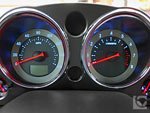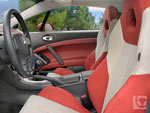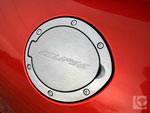 Mention the Mitsubishi Eclipse and memories instantly point to the turbocharged, all-wheel-drive GSX of 1990-1999. Sure, almost nobody bought it, but it's the one that filled the automotive history books. As the sports coupe that could burn any challenger, be raced year-round in any weather, and paved Mitsubishi's inroads to the aftermarket, it was one glorious decade for the nameplate indeed.
Mention the Mitsubishi Eclipse and memories instantly point to the turbocharged, all-wheel-drive GSX of 1990-1999. Sure, almost nobody bought it, but it's the one that filled the automotive history books. As the sports coupe that could burn any challenger, be raced year-round in any weather, and paved Mitsubishi's inroads to the aftermarket, it was one glorious decade for the nameplate indeed.But not all halos burn brightly enough, because Mitsubishi decided the benefits of the GSX, direct or otherwise, weren't lucrative enough to justify all the extra engineering expense. So the simplified Eclipse of the new millennium got more mainstream drivetrains, more comfort and refinement, more weight, and a new V6 at the top of the roster. "Geo-mechanical" styling aside, the third-generation Eclipse got deeply in touch with its sedan roots.
Those who have been hoping for a return to the 90s will have to keep on hoping for now, because it certainly didn't happen this year. What did happen is that the Eclipse moved over to a bigger, stiffer platform with new powerplants, and one of them boasts 53 more horsepower than the fastest Eclipses of days past. Hmm, what will the enthusiasts think?
Road Tests

They'll probably like the engine, the Eclipse's obvious highlight. Honda and Nissan have some pretty mean V6s of their own, but Mitsubishi took the lead in size and therefore speed, with 3.8 liters kicking out 263 horsepower despite only one overhead camshaft at its disposal. It's clear that this year's 63 extra horses couldn't care less about the extra 400 pounds, as the new car easily eclipses the former 7-second 0-60 time with its vastly quicker 5.8, making this the fastest Eclipse ever and reaffirming the Eclipse as fastest in the field. Power delivery is smooth and the revs come through loud and clear; MIVEC variable valve timing (which adds a subtle surge at 4,000 RPM) and more compression are to thank for the 33-horsepower bump over the Galant. Eclipse loyalists can rest assured that at least one part of the car is sportier than ever.
If the front tires have any say, it can get a little too sporty: the engine's 260 pounds-feet of twisting force prove to be more than they can swallow. Mashing the gas in the lower gears has the Eclipse tugging at the steering and zig-zagging down the road; mash it while turning and it surrenders into helpless understeer. There's only so much two tires can do, even ones with monstrous footprints of P235/45R18 on 18-by-8-inch rims. All-wheel-drive would really come in handy here.
Much of the rest leans toward the other end of the sport spectrum. Despite measures like beefing up the front and rear stabilizer bars from 16 / 19 to 22 / 21 (shouldn't the back bar be bigger?), the Eclipse can't hide from those pounds forever - not when there are 3,545 in all and 62% of them rest on the front axle. Note how it takes the GT's optional 18 wheels to match the stick of last year's 17s. What you get when you hustle is basically the same as in an Accord or Camry: body lean and front-end plowing at the limit, pleasant-but-not-too-interesting steering the rest of the time. By the way, an Accord EX V6 coupe weighs 169 pounds less.
The V6's new six-speed manual transmission is as trusty as an old friend, especially thanks to an easy, forgiving clutch whose action brings the word "creamy" to mind - traits definitely not shared with Mitsubishi's own Evo. But throws of the six-inch-long lever are awkwardly long and not terribly sharp, making shifting less fun than it could be. I wouldn't mind the two left pedals being firmed up a bit, either. Smoothness was clearly the emphasis here.
The benefits of smoothness extend to the Eclipse's fairly sedan-like ride (with a slight oversupply of bounce) and a fair amount of tranquility, due in part to the effects of the tall-geared transmission on an already calm engine. With always-ready power and a light touch, the Eclipse is about as user-friendly as cars get. Just as the "GT" badge implies, it makes a fine grand tourer; hundreds of miles cause little fatigue. It's just that when a car's engine and styling scream "sports car," you expect to see a few more hints of that in the driving experience in more ways than just horrible rear visibility.
A bystander asked if I like driving the Eclipse. I responded "sure, I guess" - the same thing I said after driving the Galant.
Inside & Out

If it's attention you want, attention ye shall have. Living in the region of the country where supposedly no car gets a second look, eyes were all over our Sunset Pearlescent Eclipse, with more than one "love that paint!" comment (too bad this is the one color for which Mitsubishi charges extra cash) and a lengthy interrogation by two cops (no ticket, luckily). The novelty will wear off in due time, but for now the Eclipse is the hot ticket.
A third-generation (2000-2004) Eclipse owner also commented that the insides of this car were "much better" than his. And aesthetic preferences aside, the design ain't bad. Everything's easy to reach and nothing will shock your tactile senses. The stereo conveniently reaches out to the driver from an elevated plane. Aluminum pedals are always great, and you get two power outlets. The overall layout is original, and nighttime reveals the blue-and-red color scheme everyone finds so captivating on Volkswagens. Subtle differences include map lights that are on the mirror's underside and a keyless entry trunk release taking a double-click instead of the usual long hold.
The climate controls are modeled after a manual system's yet have an automatic mode - both pluses. One quirk is how turning the temperature knob all the way to the left traps you in both A/C ON mode and recirculated air mode, and there's no label to clue you in. Electronics that think for you are annoying enough, even more so when they don't tell you.
Our Eclipse was all decked out with the much-hyped Rockford-Fosgate stereo, packing 650 ear-splitting watts through nine speakers. Uh, I counted seven - two in the doors, two tweeters, two in the rear side panels, plus a subwoofer - but it's that last one that makes it special: a 100-watt trunk-mounted sub whose bass you can hear and feel, and in a pleasant surprise can be adjusted individually from the head unit. Aside from the bass/mid/treble and speaker apportioning settings, there's also a 4-way graphic equalizer (Normal, Pop, Rock, and sadly, Country) and sound field imaging with settings of Normal, Stage, Live, and Hall. Even non-Rockford-Fosgates give MP3 playback, and those remote controls on the back of the steering wheel are just perfect, falling right where your fingers are supposed to be. The sound could be a little warmer considering those specs, though, and it's curious that Mitsubishi would leave eternal partner Infinity for Rockford-Fosgate. Isn't that trading down?
But just as the let-me-take-care-of-it climate controls and crowd-pleasing stereo further the grand tourer theme, the plush front seats keep it going, as long as you don't mind mixing leather surfaces with cloth sides. One gripe: inadequate padding in one spot means pressing yourself back into the seat results in a dagger-like stab into the lower spinal cord. Also, the omission of a telescoping steering column is a bit pathetic at this price point, though the wheel is fairly close. Front-row riders get the security of one air bag in the front and two in each door, with the passenger's automatically turning off if none is sensed.
One jaunt in the second row makes it clear this tourer was made for two. After ducking under the low roof, folding your body, and falling into a hole, the front passenger slams his seat back into your face while his low-mounted seat nearly slices off the top halves of your feet. You then spend the rest of the journey with your suffocating feet clamped down, legs asplay, and for anyone taller than George Costanza, head smashed against the hatch glass. Try not to get rear-ended (no head restraints) or broad-sided (no side air bags). If the Eclipse's constantly escalating growth and corpulence paid off somewhere (didn't the old Eclipse GS-T weigh 2,800 pounds?), it clearly wasn't in interior accommodations.
At least the hatchback design keeps cargo flexibility friendly: 15.7 cubic feet even before tumbling down the 50:50 seats and turning this into a two-door wagon. A lower liftover height than previous years should keep those chiropractor bills down.
Other Thoughts

In contrast to a time when there were five different trims to keep track of, today's Eclipse breaks it down to a simple dichotomy: the 4-cylinder-powered GS and V6-powered GT. The former starts at $19,994 while the $4,300 higher GT goes for $24,294. Like all past Eclipses, the GS starts with a 5-speed manual with a 4-speed automatic (a manually-shiftable Sportronic) optional, while the GT adds an extra gear to each transmission. The auto costs $900 in either case, making those numbers $20,894 and $25,194. Both GS and GT are pretty loaded up from the get-go, the GT's additions being fog lights, outside temperature display and compass, traction control, front strut tower brace, ventilated rear disc brakes, and a 1mm thicker rear stabilizer bar. Nothing you'll really miss.
Options are simple as well. Like the Lancer, the Eclipse GS has a Sun and Sound Package containing exactly what it implies (plus an auto-dimming rearview mirror, temperature display, and compass) for $1,500. The Eclipse GT's major option is the Premium Sport Package, supplementing those items with heated leather front buckets with power controls for the driver, heated mirrors, automatic climate control, aluminum pedals, and 18-inch alloy wheels for $3,270.
Analysis of the competition, of course, starts with identifying it. Ask the average 20something on the street and he'll probably start dropping street racer names like [Honda] Civic Si and [Acura] RSX. Well, the Type S version of the Acura is priced right where the Eclipse is and is almost as fast. Sure, but Honda's superior chassis tuning, a more capable engine that begs to be thrashed, and the 632-pound diet make that car twice as fun to drive while giving up nearly nothing in comfort or accommodations and nailing 29 miles to every gallon instead of 20. The new 2006 Civic Si makes all these same blows to the Eclipse from $4,000 below.
Or we could ignore the Eclipse's legend and judge by hardware. As a two-door Galant, the Eclipse is now a midsize sedan-based touring coupe, right? That conjures up names like Accord coupe and Camry Solara, cars that feel and are priced very much like the Eclipse. Fine, but those cars also multiply the number of habitable seats by two and a half. Which raises the question of why, exactly, Mitsubishi finds the combination of morbid obesity and silly impracticality so appealing. If the Eclipse is to go back to the world of kid racers, it had better lose some pounds and some dollars; if it wants to grow up and be a comfortable cruiser, it needs to sprout a real back seat. For now, the Eclipse clumsily straddles the line and represents the worst of both worlds.
Chalk it up to bad decision making. Sourcing one car from another may cut costs, but it also spawns the consequence of ending up with a weight and cost close to the car's origins - the Galant, in this case - no matter how much it gets shrunken in size afterwards. Put another way, the Eclipse, despite all its merits, is a philosophical mistake that somehow made it through the boardroom, down the assembly line, and into the showroom. [source : automotive.com]
Post a Comment